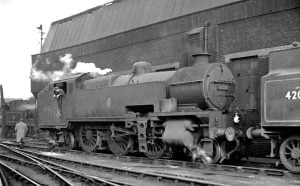Transporting various freight traffic around London yards on difficult lines, the W Class was specially designed for handling these trains.
In this article, we will look back on the history and operation of this large tank class.
SR W Class
Suburban passenger traffic dominated railway traffic around London, along with several junctions, signals and steep gradients, meant passage of freight trains through the capital was difficult.
Current engine types didn’t quite meet the exact demands, so Maunsell started to draw up plans for a new locomotive class.
Design and Construction
The current Z Class 0-8-0 were considered to take up the duties as a tank engine was preferred, but the wheel arrangement and size was not suitable. Maunsell then chose to use the 2-6-4 tank wheel arrangement with 5ft 6in coupled wheels, which would allow suitable space for water and coal, plus good for acceleration.
The bogie and leading truck would come from the rebuilt “River” Class tanks, the boiler a standard design used on other engines like the N Class. Steam brakes with a high braking force were equipped as freight stock at the time included a variety of non braked wagons.

The basic dimensions for the class as built include: 2-6-4 wheel arrangement (coupled wheels – 5 foot (ft) 6 inch (in), leading wheels – 3ft 1in and trailing ), boiler pressed at 200 lbf/in2, three cylinders (one inside, two outside) (16 1/2 in diameter and 28 in stroke), total weight came in at 90 long tons and tractive effort of 29,452 lbf (5F later 6F).
With the plans finalised, work starting on building 10 locomotives across all three major Southern Railway engine works. Ashford Works had completed the frames for five locomotives in 1930, at which point production was halted. The Great Depression in America saw a downturn in freight traffic in the UK, to the extent that production didn’t resume for 18 months, with the other reduced to five locomotives. This batch entered service from January 1932. The Southern Railway waited before continuing on building a further 10 engines, which eventually started to appear in April 1935.
Performance in Service
Built exclusively for hauling freight trains, allocations for all 15 locomotives were spread across Hither Green, Norwood Junction and Stewarts Lane for working trains mainly between Hither Green, Norwood and Feltham yards. The class proved to be brilliant engines and liked by the crews who operated them. They would also work trains to yards run by the other three ‘Big Four’ companies. The W class were tried on passenger trains when there was a high demand for passenger engines, but they proved unstable at high speeds.
The only issue with the class was the initial five built by Eastleigh Works featured right-hand drive, which made reading signals difficult as these were fitted on the left-hand side. This was overcome by the fireman keeping an eye out for signals.
Decline and Withdrawal
Although restricted to freight workings, the W class worked into the early 1960s, with the whole class withdrawn from service between 1963 and 1964.
As the title of this article reveals, all 15 engines were cut up with none being preserved. There are no official plans at the time of writing to produce a new-build W class.
We hope you have enjoyed this week’s Lost Class article.
Where Next?
News Homepage
For the Latest Railway News
RailAdvent Online Shop
Framed Prints, DVD’s / Blu-Ray’s and more
LocoStop Community
Come and share your railway pictures
Handsome locos, I seem to recall seeing them at Feltham in their last days. Of all the routes covered I never saw one at Ferme Park on the Eastern region.
I remember the W class banking from Exeter St Davids to Exeter Central in about 1963. I thought they were real handsome engines.